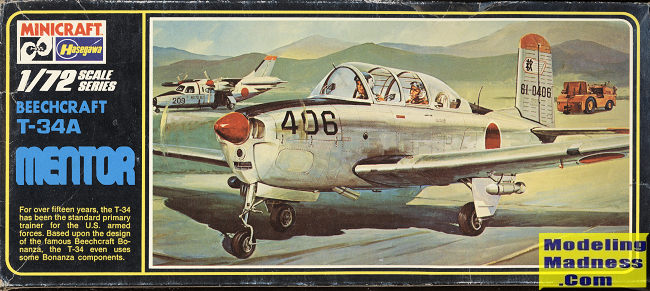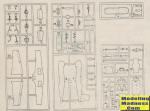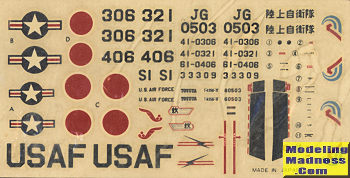
Hasegawa 1/72 T-34A 'Mentor'
| KIT #: | 088 |
| PRICE: | $cheap |
| DECALS: | Four options |
| REVIEWER: | Scott Van Aken |
| NOTES: | Includes resin and photo etch parts. |

| HISTORY |
The Beechcraft T-34 Mentor is an American propeller-driven, single-engined, military trainer aircraft derived from the Beechcraft Model 35 Bonanza. The earlier versions of the T-34, dating from around the late 1940s to the 1950s, were piston-engined. These were eventually succeeded by the upgraded T-34C Turbo-Mentor, powered by a turboprop engine. The T-34 remains in service more than six decades after it was first designed.
Production did not begin until 1953, when Beechcraft began delivering T-34As to the United States Air Force (USAF) and similar Model B45 aircraft for export. Production of the T-34B for the United States Navy (USN) began in 1955, this version featuring a number of changes reflecting the different requirements of the two services. The T-34B had only differential braking for steering control on the ground instead of nosewheel steering, additional wing dihedral and, to cater for the different heights of pilots, adjustable rudder pedals instead of the moveable seats of the T-34A. T-34A production was completed in 1956, with T-34Bs being built until October 1957 and licensed B45 versions built in Canada (125 manufactured by Canadian Car and Foundry), Japan (173 built by Fuji Heavy Industries), and Argentina (75 by FMA) until 1958. Beechcraft delivered the last Model B45s in 1959. Total production of the Continental-engined versions in the US and abroad was 1,904 aircraft.
| THE KIT |
 When
Hasegawa started to do a lot of aircraft in 1/72, they did a lot of kits of
plane operated by the Japanese air forces. In 1973, they chose to do the T-34.
This was a logical move as the type was license build in country. It also
provided a basis for the later Fuji T-3, which was the same airframe but with a
supercharged engine.
When
Hasegawa started to do a lot of aircraft in 1/72, they did a lot of kits of
plane operated by the Japanese air forces. In 1973, they chose to do the T-34.
This was a logical move as the type was license build in country. It also
provided a basis for the later Fuji T-3, which was the same airframe but with a
supercharged engine.
The kit is molded on three grey and one clear sprue. One of the grey sprues contains a Toyota tow tractor. This kit was also released by Minicraft in 1977 with English instructions.
Cockpit is quite basic with a floor, two seats, two pilot figures and instrument panels. The upper wing halves need to have the landing gear installed before being joined to the lower wing to deal with the retraction strut. Once the fuselage halves are glued together, there is a forward cowling piece that holds the prop. It will be a real challenge to find room for weight in this one as it is quite the tail sitter.
With the lower wing attached, the upper wing halves with the
gear can be attached. During this step the inner gear doors (normally closed)
and the tailplanes are glued on. the last steps are for the nose gear, remaining
gear doors and the canopy. There are pylons with practice bombs under the wing,
but I'd fill the holes as most photos of this plane do not have this. The rest of the instructions
cover the building of the tow tractor, which seems to have more parts than the
aircraft.
as most photos of this plane do not have this. The rest of the instructions
cover the building of the tow tractor, which seems to have more parts than the
aircraft.
My kit is one of those 1977 Minicraft releases and has been through a lot, Though the kit bag is unopened, the decals are well past being useful so one will need to locate replacements. The kit offers several Japanese training units and camouflage schemes as well as a non-descript USAF version.
| CONCLUSIONS |
As is often the case with some older kits, in 1/72, this is is for the piston Mentor. It does make into a nice model and if you are handy in piecing together markings, you'll have a very nice, but fairly small addition to your collection.
| REFERENCES |
https://en.wikipedia.org/wiki/Beechcraft_T-34_Mentor
October 2020 Copyright ModelingMadness.com. All rights
reserved. If you would like your product reviewed fairly and fairly quickly, please
contact
the editor or see other details in the
Note to
Contributors. Back to the Main Page
Back to the Review
Index Page
Back to the Previews Index Page